ikfoundation.org
The IK Foundation
Promoting Natural & Cultural History
Since 1988


AN 1870s WOOLLEN DOLMAN
– and Contemporary Garments
The project and book The Textile History of Whitby 1700-1914, presents some outer garments in various designs from the Victorian period kept at Whitby Museum. Relatively few full-length capes, including a large quantity of cloth, have been preserved since the fabric was ideal for recycling to make children’s clothes and the like once the original was out of fashion. Whilst half-length garments have been saved to a greater extent. One such example is this woollen dolman originating from the 1870s, demonstrating a practical use for the up-to-date fashion of the time together with great skill in design, hand stitching and machine-worked features.
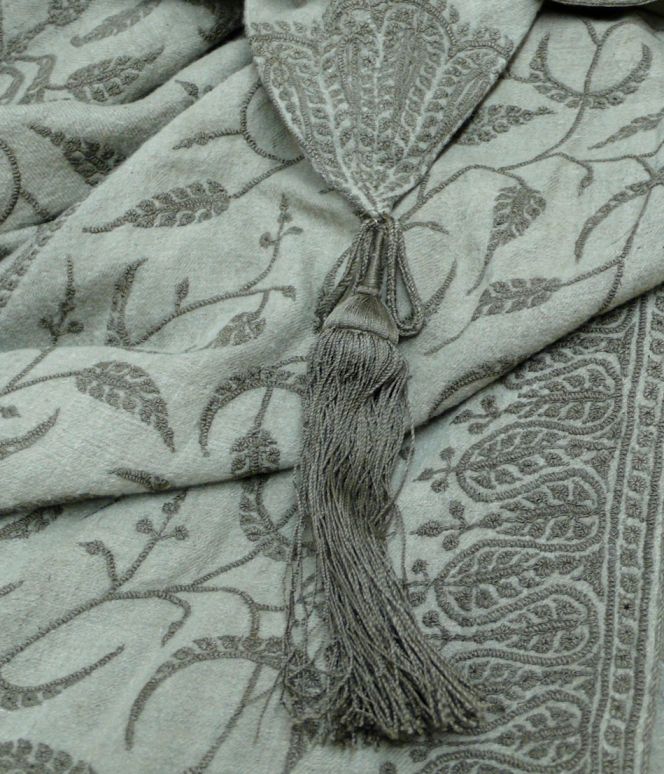 Close-up image of the grey woollen dolman with its intricate embroidery in tone with the fabric. The stitching with its “Eastern” inspired leaf motif is machine-made while the garment over all is completed with both hand and machine stitching. The hood is finished of with this beautiful silk tassel, centred in the image. (Whitby Museum, Costume Collection, no number at time of research). Photo: The IK Foundation, London.
Close-up image of the grey woollen dolman with its intricate embroidery in tone with the fabric. The stitching with its “Eastern” inspired leaf motif is machine-made while the garment over all is completed with both hand and machine stitching. The hood is finished of with this beautiful silk tassel, centred in the image. (Whitby Museum, Costume Collection, no number at time of research). Photo: The IK Foundation, London.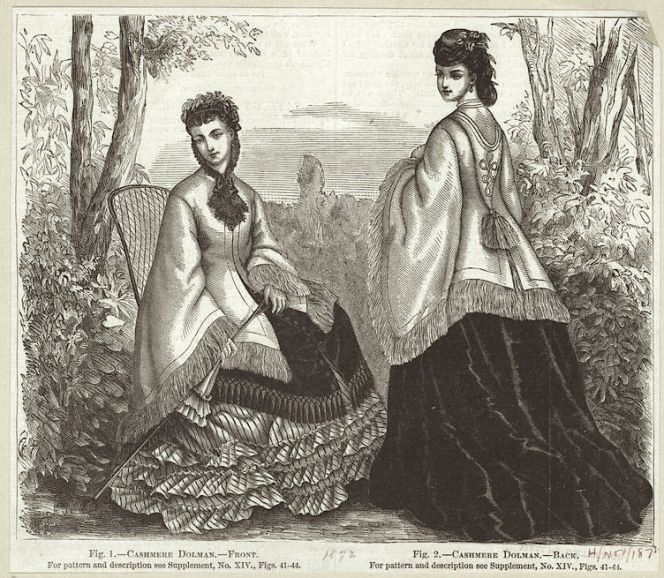 To be compared with the shape and size of this contemporary dolman, published in Harpers’s Bazaar November 1871 (Courtesy of: New York Public Library Digital Gallery Website).
To be compared with the shape and size of this contemporary dolman, published in Harpers’s Bazaar November 1871 (Courtesy of: New York Public Library Digital Gallery Website).This variety of outerwear was known as a dolman, or a so-called half cape designed to rest on the bustle and often made from weighty and expensive material. Capes/mantles of this type sometimes also had added fur details, though none is included in the Whitby collection. The dolman for the European and North American tailored wardrobe also often displays “Eastern” inspiration in shaping and design, fringed borders, embellishing braiding, embroidery details and tassels – which are clearly visible characteristics for both the discussed grey woollen dolman and the accompanying fashion illustration dated 1871.
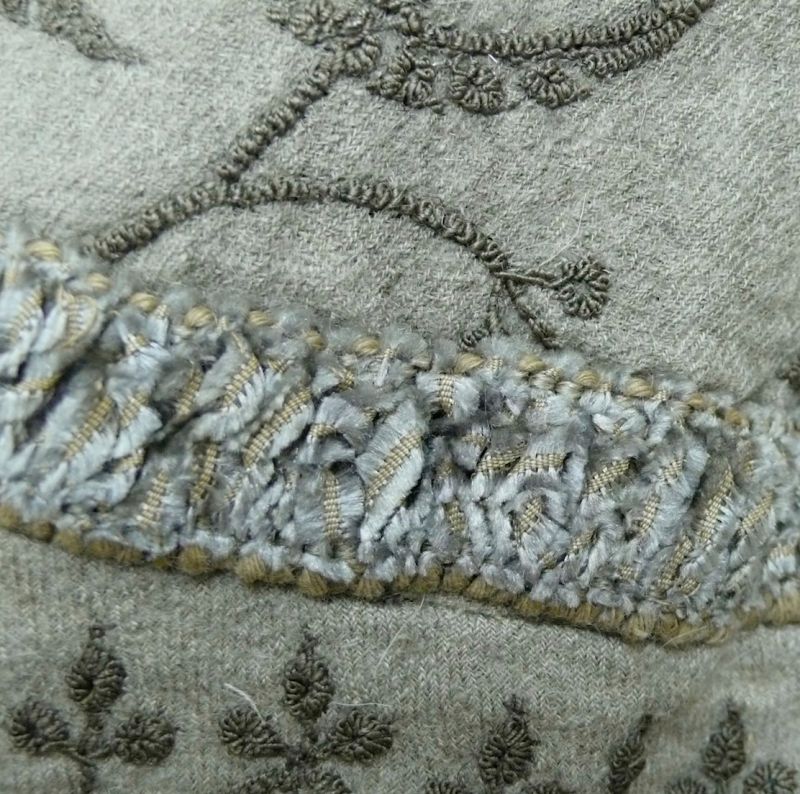 The garment is altogether professionally made including features as; parts of the back lined with a dark grey silk fabric, while this close-up image showing the decorative silk braids harmonising with the machine embroidery to a high fashionable standard. (Whitby Museum, Costume Collection) Photo: The IK Foundation, London.
The garment is altogether professionally made including features as; parts of the back lined with a dark grey silk fabric, while this close-up image showing the decorative silk braids harmonising with the machine embroidery to a high fashionable standard. (Whitby Museum, Costume Collection) Photo: The IK Foundation, London.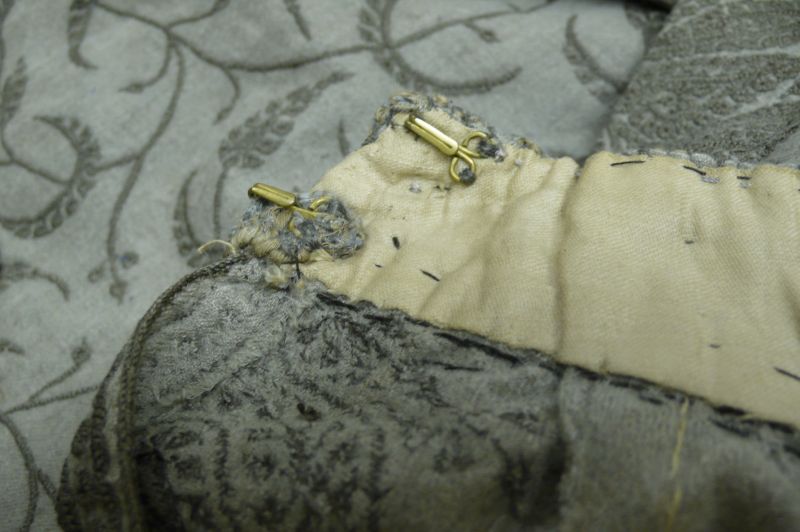 This final detail of the 1870s dolman – from the inside – displaying how the garment was fastened with hooks and eyes by the neck, together with the mantle makers long tacking stitching still intact. (Whitby Museum, Costume Collection) Photo: The IK Foundation, London.
This final detail of the 1870s dolman – from the inside – displaying how the garment was fastened with hooks and eyes by the neck, together with the mantle makers long tacking stitching still intact. (Whitby Museum, Costume Collection) Photo: The IK Foundation, London.The collection at Whitby Museum also includes a wide range of garments suitable for mourning, including mantles, capes, collars, skirts, blouses, hats and dresses, mostly dating from the 1870s to 1890s. Especially significant is the extraordinary selection of capes and mantles, often made of velvet or satin and decorated with jet-stones, beads, sequins, embroidery, silk ribbons and laces.
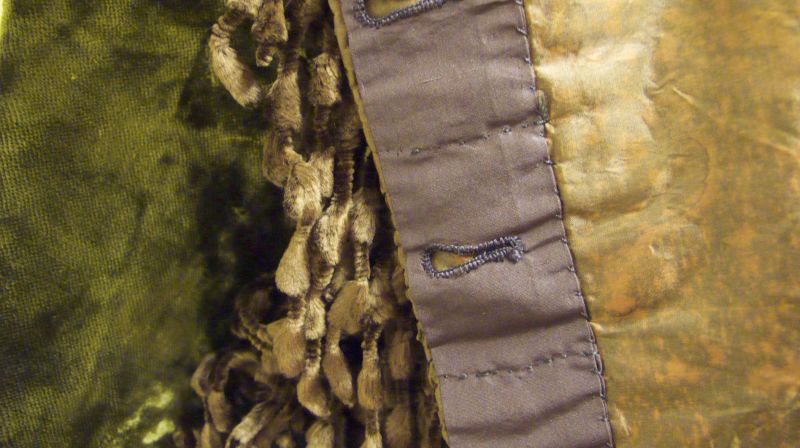 Another well-made and elegant dolman in the Whitby collection probably dates from the same period, 1870s-80s, having similar features as the grey woollen outerwear. But this garment was made of a sturdy green silk fabric with added brown velvet fringes, fastened with buttons in front and lined with brown silk. (Whitby Museum, Costume Collection, K 24) Photo: The IK Foundation, London.
Another well-made and elegant dolman in the Whitby collection probably dates from the same period, 1870s-80s, having similar features as the grey woollen outerwear. But this garment was made of a sturdy green silk fabric with added brown velvet fringes, fastened with buttons in front and lined with brown silk. (Whitby Museum, Costume Collection, K 24) Photo: The IK Foundation, London.Sources:
- Hansen, Viveka, The Textile History of Whitby 1700-1914, Whitby & London 2015 (research material, pre-publishing).
- Whitby Museum, Costume Collection (studies of Victorian garments).
Essays
The iTEXTILIS is a division of The IK Workshop Society – a global and unique forum for all those interested in Natural & Cultural History from a textile Perspective.
Open Access essays, licensed under Creative Commons and freely accessible, by Textile historian Viveka Hansen, aim to integrate her current research, printed monographs, and earlier projects dating back to the late 1980s. Some essays feature rare archive material originally published in other languages, now available in English for the first time, revealing aspects of history that were previously little known outside northern European countries. Her work also explores various topics, including the textile trade, material culture, cloth manufacturing, fashion, natural dyeing, and the intriguing world of early travelling naturalists – such as the "Linnaean network" – viewed through a global historical lens.
For regular updates and to fully utilise iTEXTILIS' features, we recommend subscribing to our newsletter, iMESSENGER.
been copied to your clipboard




– a truly European organisation since 1988
Legal issues | Forget me | and much more...
You are welcome to use the information and knowledge from
The IK Workshop Society, as long as you follow a few simple rules.
LEARN MORE & I AGREE







